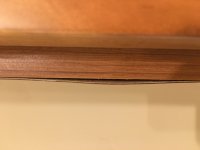My wife and I bought a "Spec House" about 6 years ago. Typically in spec houses there are shortcuts taken to keep the cost down as much as possible but overall we have been very happy with the quality of the construction. However, we have started to run into a problem with the kitchen cabinets. The cabinets have knotty alder doors with veneered boxes.
The problem I am having is that I am starting to see the veneer on end cabinets delaminating from the boxes. I've attached a close up photo to show the issue. I figure that I have one shot to fix this so I wanted to ask the pros how they would address the issue before I force some glue in, clamp it, not have it hold, and have covered the interior surfaces with dried glue making another try at fixing it impossible.
Any help that can be offered would be greatly appreciated.
Thanks in advance
The problem I am having is that I am starting to see the veneer on end cabinets delaminating from the boxes. I've attached a close up photo to show the issue. I figure that I have one shot to fix this so I wanted to ask the pros how they would address the issue before I force some glue in, clamp it, not have it hold, and have covered the interior surfaces with dried glue making another try at fixing it impossible.
Any help that can be offered would be greatly appreciated.
Thanks in advance


